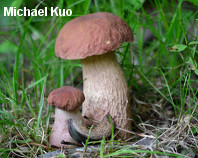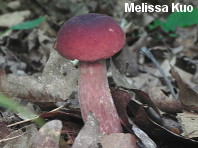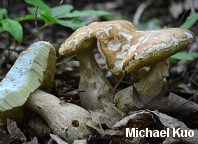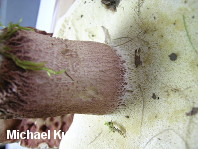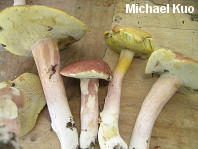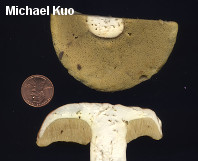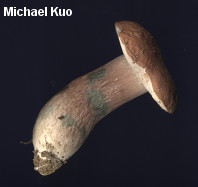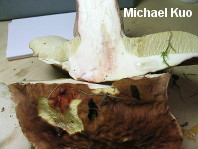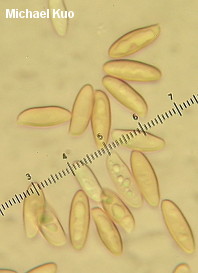| Major Groups > Boletes > Edulis Group > Boletus separans |

|
Boletus separans [ Basidiomycota > Boletales > Boletaceae > Boletus . . . ] by Michael Kuo Here is an attractive and fairly easily identified bolete, found under oaks and other hardwoods east of the Rocky Mountains. Crucial identifying features include its yellow (not olive) mature pore surface, and the distinctive, liver-red flush on the stem. The young caps are also often colored liver-red, but they often become more or less brown at maturity, and brownish yellow in old age. To be certain of your identification, place a drop of common household ammonia on the liver-flushed areas of the stem of Boletus separans: the result is a color change to deep blue-green. This species was originally described as a species of Boletus by Peck (1873), but was moved to Xanthoconium by Halling and Both in 1998, since its mature pore surface lacks olive shades and its surfaces turn green with alkali (features shared in whole or in part with Xanthoconium purpureum and Xanthoconium affine). However, recent molecular investigations (Dentinger and collaborators, 2010; Nuhn and collaborators, 2013) have returned the species to a newly re-defined Boletus that includes only species closely related to Boletus edulis, the type species of the genus. Xanthoconium separans is a synonym. Boletus pseudoseparans is a probable synonym. Thanks to Pandra Williams for collecting, documenting, and preserving Boletus separans for study; her collection is deposited in The Herbarium of Michael Kuo. Description: Ecology: Mycorrhizal with oaks (and possibly with other hardwoods) and, more rarely, with conifers (including slash pine); growing alone, scattered, or gregariously; summer and fall; widely distributed east of the Rocky Mountains. The illustrated and described collections are from Illinois and Georgia. Cap: 4-20 cm across; convex, becoming broadly convex in age; sticky when fresh, but soon dry; usually somewhat wrinkled; very finely velvety when young, but soon bald; lilac-brown to liver-red or cinnamon when young; lilac shades often disappearing in old age; at maturity yellowish brown to golden. Pore Surface: White when young, becoming yellowish and finally bright brownish yellow (without olive shades); not bruising, or bruising deeper yellow or brownish when mature; pores "stuffed" when young; at maturity with 1-3 circular pores per mm at maturity; tubes 5-20 mm deep. Stem: 4-12 cm long; 1-4 cm thick; usually club-shaped when young, becoming more or less equal with maturity; solid; bald; usually slightly wrinkled; weakly to prominently reticulate, over the apex or overall; pale above; usually flushed with the cap color in places below; sometimes developing yellow stains, especially near the apex; in old age often whitish to grayish, without any lilac shades; basal mycelium white. Flesh: Whitish throughout, unchanging on exposure or bruising. Odor and Taste: Pleasant; not distinctive. Chemical Reactions: Ammonia green on cap surface when lilac shades are present (otherwise pinkish to negative); green on lilac-flushed areas of stem surface; negative to pinkish on flesh. KOH flashing green, then negative or dark brown on cap surface; sea green on lilac-flushed areas of the stem sea green; purple, resolving to pale pinkish on flesh. Iron salts gray on cap surface; negative to grayish on flesh. Spore Print: Brownish to yellowish brown. Microscopic Features: Spores 11-15 x 4-5.5 µ; smooth; fusiform; yellowish in KOH. Hymenial cystidia absent. Pileipellis a tightly packed palisadoderm/epithelium; elements hyaline in KOH (or, when fresh, green); terminal cells clavate to obpyriform, 10-15 µ wide. REFERENCES: Peck, 1873. (Saccardo, 1888; Coker & Beers, 1943; Smith & Thiers, 1971; Grund & Harrison, 1976; Smith, Smith & Weber, 1981; Phillips, 1991/2005; Both, 1993; Halling & Both, 1998; Bessette, Roody & Bessette, 2000; Roody, 2003; McNeil, 2006; Kuo, 2007; Dentinger et al., 2010; Nuhn et al., 2013; Kuo & Methven, 2014.) Herb. Kuo 07299701, 08270206, 08240504, 07060703, 06201002, 09231401. This site contains no information about the edibility or toxicity of mushrooms. |
© MushroomExpert.Com |
|
Cite this page as: Kuo, M. (2015, January). Boletus separans. Retrieved from the MushroomExpert.Com Web site: http://www.mushroomexpert.com/boletus_separans.html |
